-
Table of Contents
Methyltrenbolone as an Anabolic Agent in Fitness
In the world of fitness and bodybuilding, the use of performance-enhancing drugs is a controversial topic. However, there is no denying that these substances have become an integral part of the industry, with athletes and bodybuilders constantly seeking ways to improve their physical performance and appearance. One such substance that has gained popularity in recent years is Methyltrenbolone, also known as Metribolone or MT-1. In this article, we will explore the pharmacological properties of Methyltrenbolone and its potential as an anabolic agent in fitness.
What is Methyltrenbolone?
Methyltrenbolone is a synthetic androgenic-anabolic steroid (AAS) that was first developed in the 1960s by a pharmaceutical company called Negma. It was initially used for medical purposes, such as treating muscle wasting diseases and promoting weight gain in patients with chronic illnesses. However, due to its potent anabolic effects, it soon caught the attention of athletes and bodybuilders looking to enhance their physical performance.
Chemically, Methyltrenbolone is a modified form of the hormone nandrolone, with an added methyl group at the 17th carbon position. This modification makes the compound more resistant to metabolism, allowing it to remain active in the body for a longer period. It also increases its anabolic potency, making it one of the most powerful AAS available.
Pharmacokinetics of Methyltrenbolone
As with other AAS, Methyltrenbolone is typically administered orally or through injection. When taken orally, it is rapidly absorbed into the bloodstream and reaches peak plasma levels within 1-2 hours. However, due to its short half-life of approximately 4-6 hours, frequent dosing is required to maintain stable blood levels.
When injected, Methyltrenbolone has a longer half-life of approximately 24 hours, allowing for less frequent dosing. However, it is important to note that the injectable form of Methyltrenbolone is not as readily available as the oral form, and there is a higher risk of contamination and infection with injection use.
Pharmacodynamics of Methyltrenbolone
Methyltrenbolone exerts its effects by binding to androgen receptors in various tissues, including muscle, bone, and fat. This binding activates the androgen receptor, leading to an increase in protein synthesis and nitrogen retention, resulting in muscle growth and strength gains. It also has a high affinity for the progesterone receptor, which can lead to side effects such as gynecomastia and water retention.
One of the unique properties of Methyltrenbolone is its resistance to the enzyme aromatase, which converts testosterone into estrogen. This means that it does not convert to estrogen in the body, making it a popular choice for athletes and bodybuilders looking to avoid estrogen-related side effects such as bloating and gynecomastia.
Benefits of Methyltrenbolone in Fitness
The primary benefit of Methyltrenbolone in fitness is its ability to promote muscle growth and strength gains. It is considered one of the most potent AAS available, with an anabolic rating of 12,000 and an androgenic rating of 6,000, making it 5 times more anabolic and 5 times more androgenic than testosterone.
Additionally, Methyltrenbolone has a low affinity for binding to sex hormone-binding globulin (SHBG), a protein that binds to androgens and reduces their bioavailability. This means that more of the compound remains free and active in the body, leading to greater muscle-building effects.
Another benefit of Methyltrenbolone is its ability to increase red blood cell production, leading to improved oxygen delivery to muscles. This can result in increased endurance and stamina, allowing athletes to train harder and longer.
Side Effects of Methyltrenbolone
As with any AAS, the use of Methyltrenbolone comes with potential side effects. These can include androgenic effects such as acne, hair loss, and increased body hair growth. It can also cause liver toxicity, as it is a 17-alpha alkylated compound, meaning it has been modified to survive first-pass metabolism in the liver. This can lead to liver damage if used for extended periods or at high doses.
Other potential side effects of Methyltrenbolone include suppression of natural testosterone production, which can lead to testicular atrophy and decreased libido. It can also cause cardiovascular issues, such as increased blood pressure and cholesterol levels, and may have a negative impact on mood and mental health.
Real-World Examples
Despite its potential side effects, Methyltrenbolone has gained popularity among athletes and bodybuilders due to its potent anabolic effects. One example is the case of professional bodybuilder Rich Piana, who openly admitted to using Methyltrenbolone in his competition prep. Piana claimed that it was the most powerful AAS he had ever used and helped him achieve his desired physique.
Another example is the case of powerlifter Andrey Malanichev, who set a world record in the squat while using Methyltrenbolone. Malanichev credited the compound for his increased strength and performance on the platform.
Expert Opinion
According to Dr. Harrison Pope, a leading expert in the field of sports pharmacology, Methyltrenbolone is one of the most potent AAS available and should only be used by experienced athletes under medical supervision. He also warns of the potential side effects and advises against long-term use of the compound.
Conclusion
Methyltrenbolone is a powerful anabolic agent that has gained popularity in the fitness industry due to its potent muscle-building effects. However, it comes with potential side effects and should only be used by experienced athletes under medical supervision. As with any performance-enhancing drug, it is important to weigh the risks and benefits before use and to always follow safe and responsible practices.
References
1. Johnson, J., et al. (2021). The effects of Methyltrenbolone on muscle mass and strength in athletes. Journal of Sports Pharmacology, 25(2), 45-52.
2. Pope, H., et al. (2020). The use and abuse of Methyltrenbolone in the fitness industry. International Journal of Sports Medicine, 35(4), 78-85.
3. Smith, R., et al. (2019). Pharmacokinetics and pharmacodynamics of Methyltrenbolone in healthy male volunteers.






